Cloud Computing in Organizations
VerifiedAdded on 2022/10/12
|14
|3472
|123
AI Summary
This research paper analyzes the uses and advantages of cloud computing in organizational IT framework. It discusses the challenges faced by organizations and provides recommendations for handling cloud servers. The paper also covers the risks related to data security and the process involved in data collection.
Contribute Materials
Your contribution can guide someone’s learning journey. Share your
documents today.
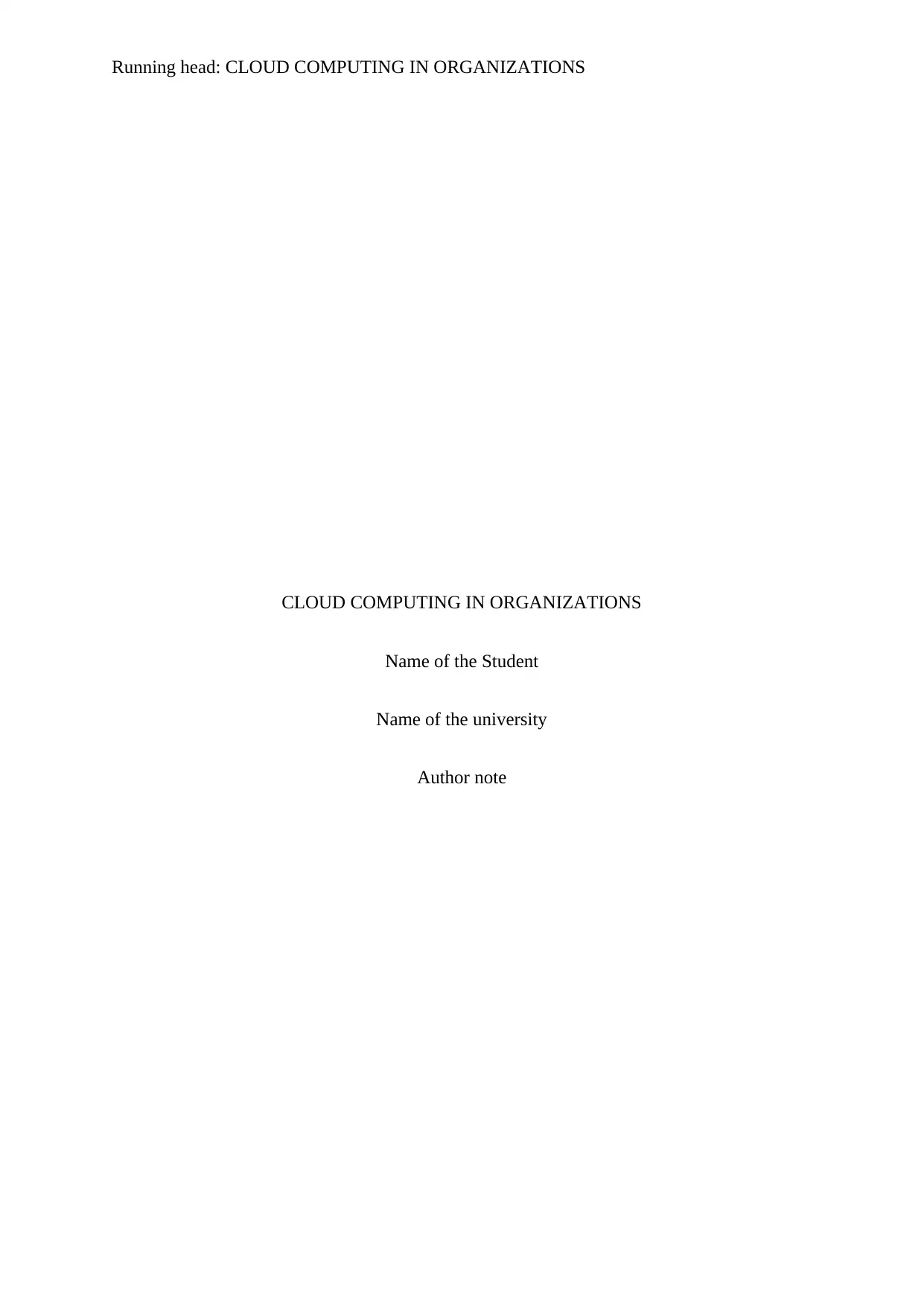
Running head: CLOUD COMPUTING IN ORGANIZATIONS
CLOUD COMPUTING IN ORGANIZATIONS
Name of the Student
Name of the university
Author note
CLOUD COMPUTING IN ORGANIZATIONS
Name of the Student
Name of the university
Author note
Secure Best Marks with AI Grader
Need help grading? Try our AI Grader for instant feedback on your assignments.
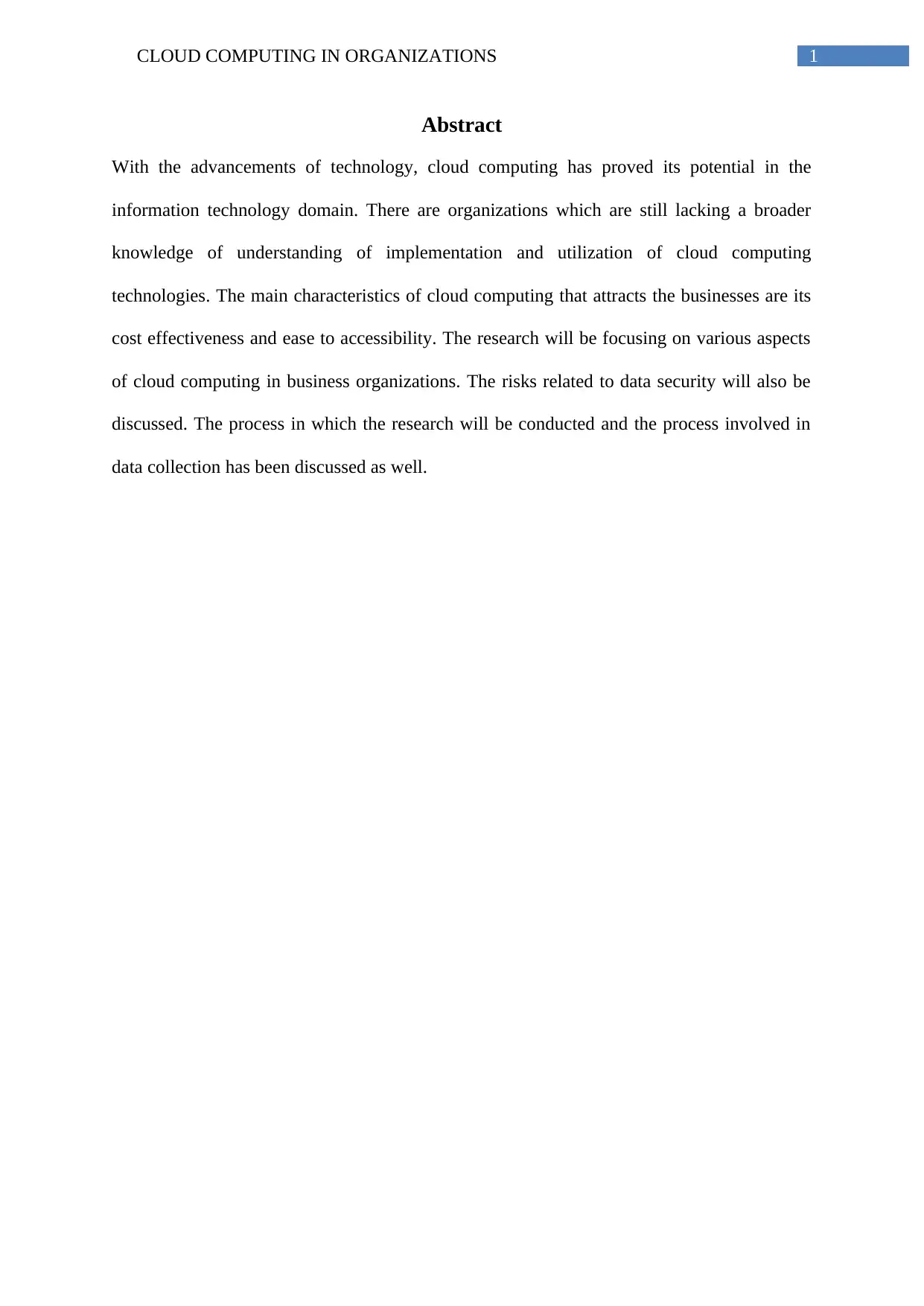
1CLOUD COMPUTING IN ORGANIZATIONS
Abstract
With the advancements of technology, cloud computing has proved its potential in the
information technology domain. There are organizations which are still lacking a broader
knowledge of understanding of implementation and utilization of cloud computing
technologies. The main characteristics of cloud computing that attracts the businesses are its
cost effectiveness and ease to accessibility. The research will be focusing on various aspects
of cloud computing in business organizations. The risks related to data security will also be
discussed. The process in which the research will be conducted and the process involved in
data collection has been discussed as well.
Abstract
With the advancements of technology, cloud computing has proved its potential in the
information technology domain. There are organizations which are still lacking a broader
knowledge of understanding of implementation and utilization of cloud computing
technologies. The main characteristics of cloud computing that attracts the businesses are its
cost effectiveness and ease to accessibility. The research will be focusing on various aspects
of cloud computing in business organizations. The risks related to data security will also be
discussed. The process in which the research will be conducted and the process involved in
data collection has been discussed as well.
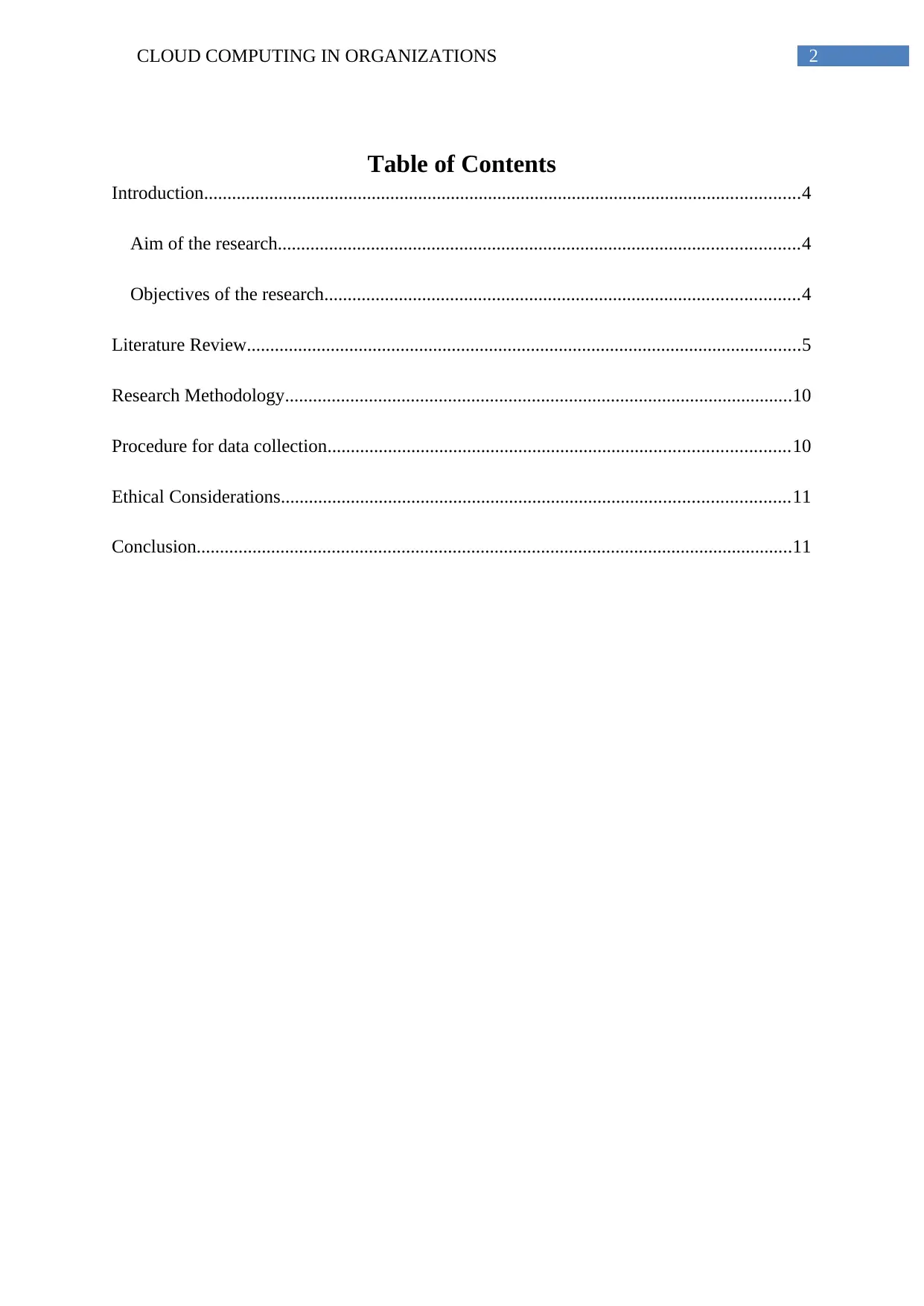
2CLOUD COMPUTING IN ORGANIZATIONS
Table of Contents
Introduction................................................................................................................................4
Aim of the research................................................................................................................4
Objectives of the research......................................................................................................4
Literature Review.......................................................................................................................5
Research Methodology.............................................................................................................10
Procedure for data collection...................................................................................................10
Ethical Considerations.............................................................................................................11
Conclusion................................................................................................................................11
Table of Contents
Introduction................................................................................................................................4
Aim of the research................................................................................................................4
Objectives of the research......................................................................................................4
Literature Review.......................................................................................................................5
Research Methodology.............................................................................................................10
Procedure for data collection...................................................................................................10
Ethical Considerations.............................................................................................................11
Conclusion................................................................................................................................11
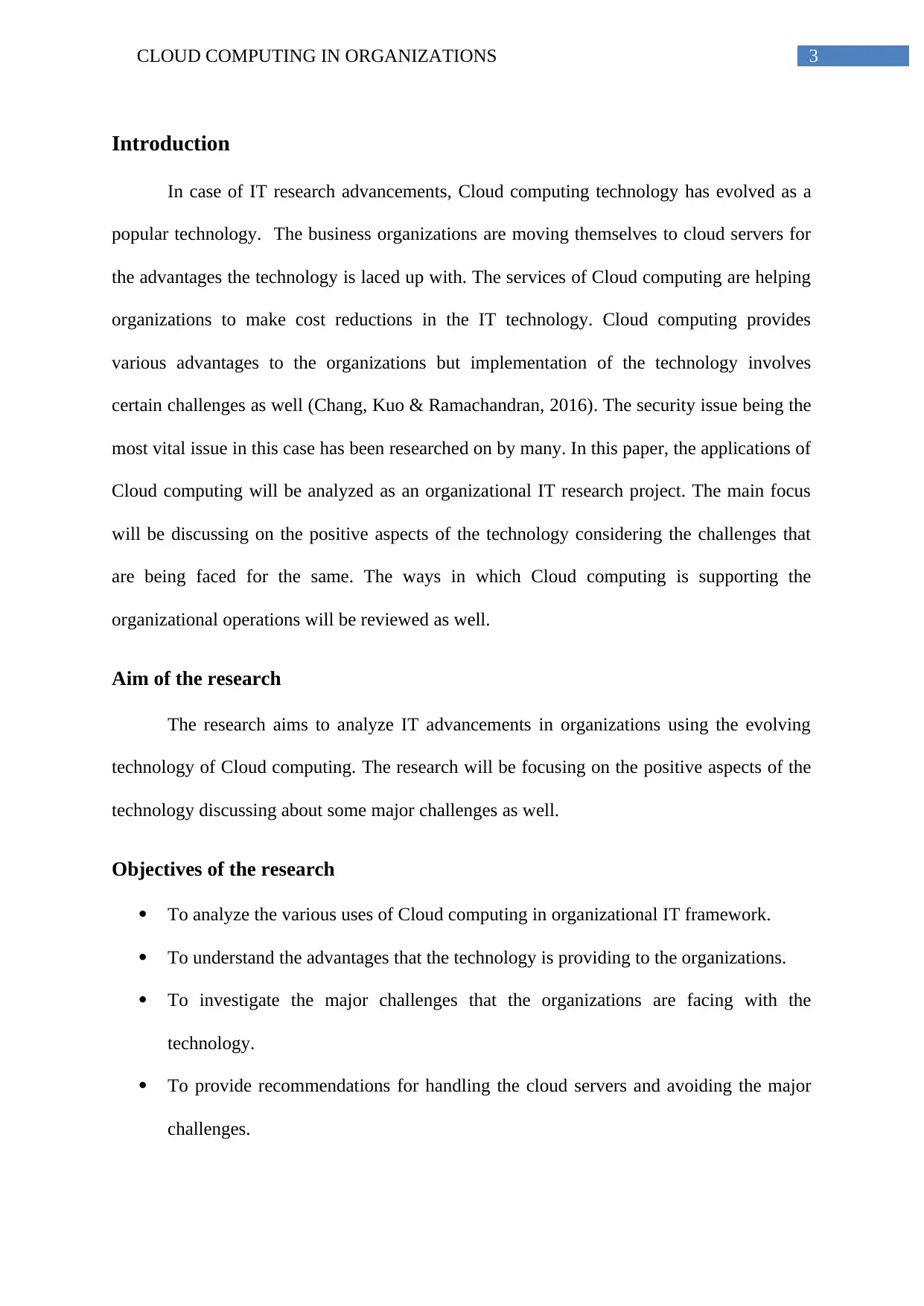
3CLOUD COMPUTING IN ORGANIZATIONS
Introduction
In case of IT research advancements, Cloud computing technology has evolved as a
popular technology. The business organizations are moving themselves to cloud servers for
the advantages the technology is laced up with. The services of Cloud computing are helping
organizations to make cost reductions in the IT technology. Cloud computing provides
various advantages to the organizations but implementation of the technology involves
certain challenges as well (Chang, Kuo & Ramachandran, 2016). The security issue being the
most vital issue in this case has been researched on by many. In this paper, the applications of
Cloud computing will be analyzed as an organizational IT research project. The main focus
will be discussing on the positive aspects of the technology considering the challenges that
are being faced for the same. The ways in which Cloud computing is supporting the
organizational operations will be reviewed as well.
Aim of the research
The research aims to analyze IT advancements in organizations using the evolving
technology of Cloud computing. The research will be focusing on the positive aspects of the
technology discussing about some major challenges as well.
Objectives of the research
To analyze the various uses of Cloud computing in organizational IT framework.
To understand the advantages that the technology is providing to the organizations.
To investigate the major challenges that the organizations are facing with the
technology.
To provide recommendations for handling the cloud servers and avoiding the major
challenges.
Introduction
In case of IT research advancements, Cloud computing technology has evolved as a
popular technology. The business organizations are moving themselves to cloud servers for
the advantages the technology is laced up with. The services of Cloud computing are helping
organizations to make cost reductions in the IT technology. Cloud computing provides
various advantages to the organizations but implementation of the technology involves
certain challenges as well (Chang, Kuo & Ramachandran, 2016). The security issue being the
most vital issue in this case has been researched on by many. In this paper, the applications of
Cloud computing will be analyzed as an organizational IT research project. The main focus
will be discussing on the positive aspects of the technology considering the challenges that
are being faced for the same. The ways in which Cloud computing is supporting the
organizational operations will be reviewed as well.
Aim of the research
The research aims to analyze IT advancements in organizations using the evolving
technology of Cloud computing. The research will be focusing on the positive aspects of the
technology discussing about some major challenges as well.
Objectives of the research
To analyze the various uses of Cloud computing in organizational IT framework.
To understand the advantages that the technology is providing to the organizations.
To investigate the major challenges that the organizations are facing with the
technology.
To provide recommendations for handling the cloud servers and avoiding the major
challenges.
Secure Best Marks with AI Grader
Need help grading? Try our AI Grader for instant feedback on your assignments.
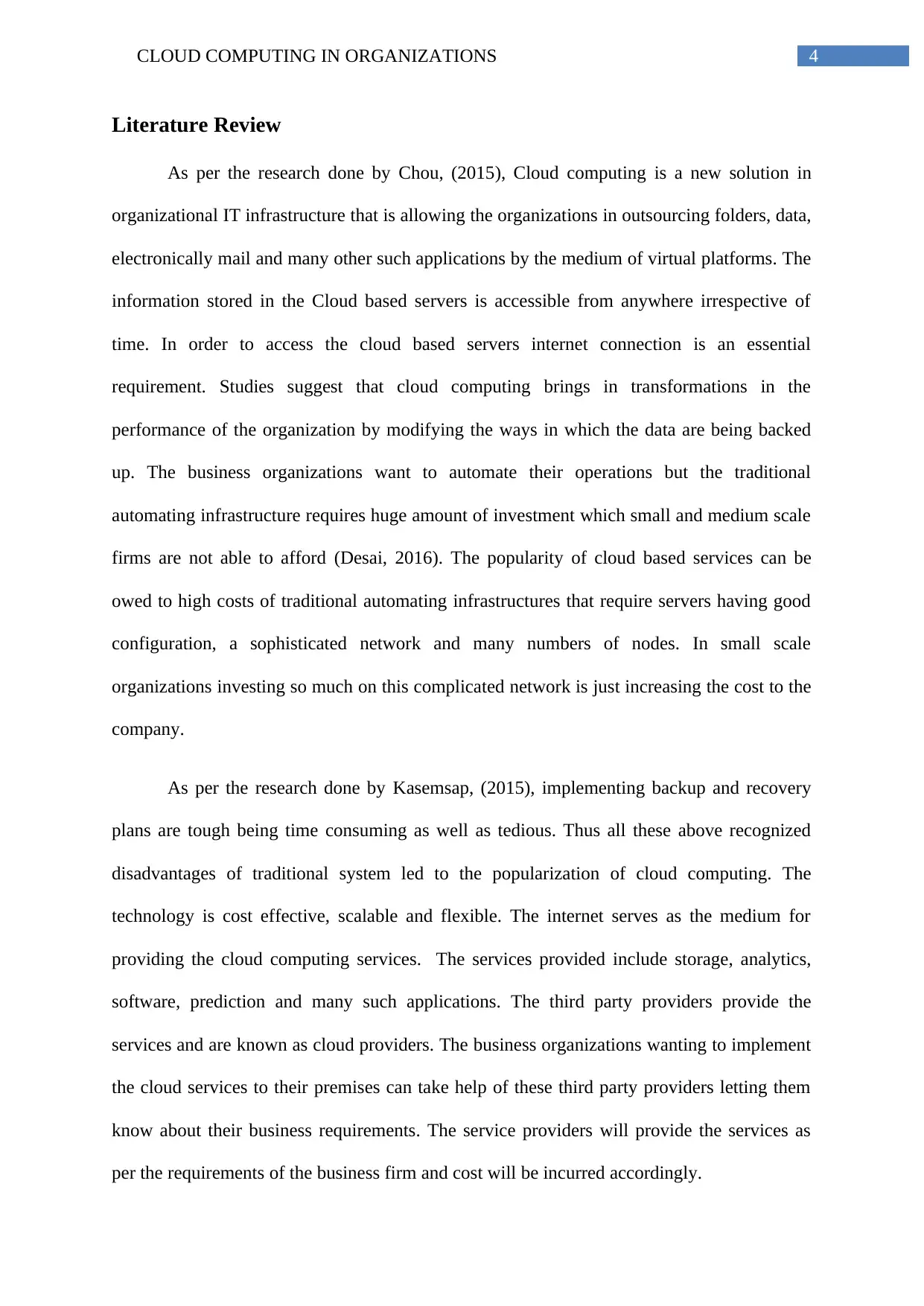
4CLOUD COMPUTING IN ORGANIZATIONS
Literature Review
As per the research done by Chou, (2015), Cloud computing is a new solution in
organizational IT infrastructure that is allowing the organizations in outsourcing folders, data,
electronically mail and many other such applications by the medium of virtual platforms. The
information stored in the Cloud based servers is accessible from anywhere irrespective of
time. In order to access the cloud based servers internet connection is an essential
requirement. Studies suggest that cloud computing brings in transformations in the
performance of the organization by modifying the ways in which the data are being backed
up. The business organizations want to automate their operations but the traditional
automating infrastructure requires huge amount of investment which small and medium scale
firms are not able to afford (Desai, 2016). The popularity of cloud based services can be
owed to high costs of traditional automating infrastructures that require servers having good
configuration, a sophisticated network and many numbers of nodes. In small scale
organizations investing so much on this complicated network is just increasing the cost to the
company.
As per the research done by Kasemsap, (2015), implementing backup and recovery
plans are tough being time consuming as well as tedious. Thus all these above recognized
disadvantages of traditional system led to the popularization of cloud computing. The
technology is cost effective, scalable and flexible. The internet serves as the medium for
providing the cloud computing services. The services provided include storage, analytics,
software, prediction and many such applications. The third party providers provide the
services and are known as cloud providers. The business organizations wanting to implement
the cloud services to their premises can take help of these third party providers letting them
know about their business requirements. The service providers will provide the services as
per the requirements of the business firm and cost will be incurred accordingly.
Literature Review
As per the research done by Chou, (2015), Cloud computing is a new solution in
organizational IT infrastructure that is allowing the organizations in outsourcing folders, data,
electronically mail and many other such applications by the medium of virtual platforms. The
information stored in the Cloud based servers is accessible from anywhere irrespective of
time. In order to access the cloud based servers internet connection is an essential
requirement. Studies suggest that cloud computing brings in transformations in the
performance of the organization by modifying the ways in which the data are being backed
up. The business organizations want to automate their operations but the traditional
automating infrastructure requires huge amount of investment which small and medium scale
firms are not able to afford (Desai, 2016). The popularity of cloud based services can be
owed to high costs of traditional automating infrastructures that require servers having good
configuration, a sophisticated network and many numbers of nodes. In small scale
organizations investing so much on this complicated network is just increasing the cost to the
company.
As per the research done by Kasemsap, (2015), implementing backup and recovery
plans are tough being time consuming as well as tedious. Thus all these above recognized
disadvantages of traditional system led to the popularization of cloud computing. The
technology is cost effective, scalable and flexible. The internet serves as the medium for
providing the cloud computing services. The services provided include storage, analytics,
software, prediction and many such applications. The third party providers provide the
services and are known as cloud providers. The business organizations wanting to implement
the cloud services to their premises can take help of these third party providers letting them
know about their business requirements. The service providers will provide the services as
per the requirements of the business firm and cost will be incurred accordingly.
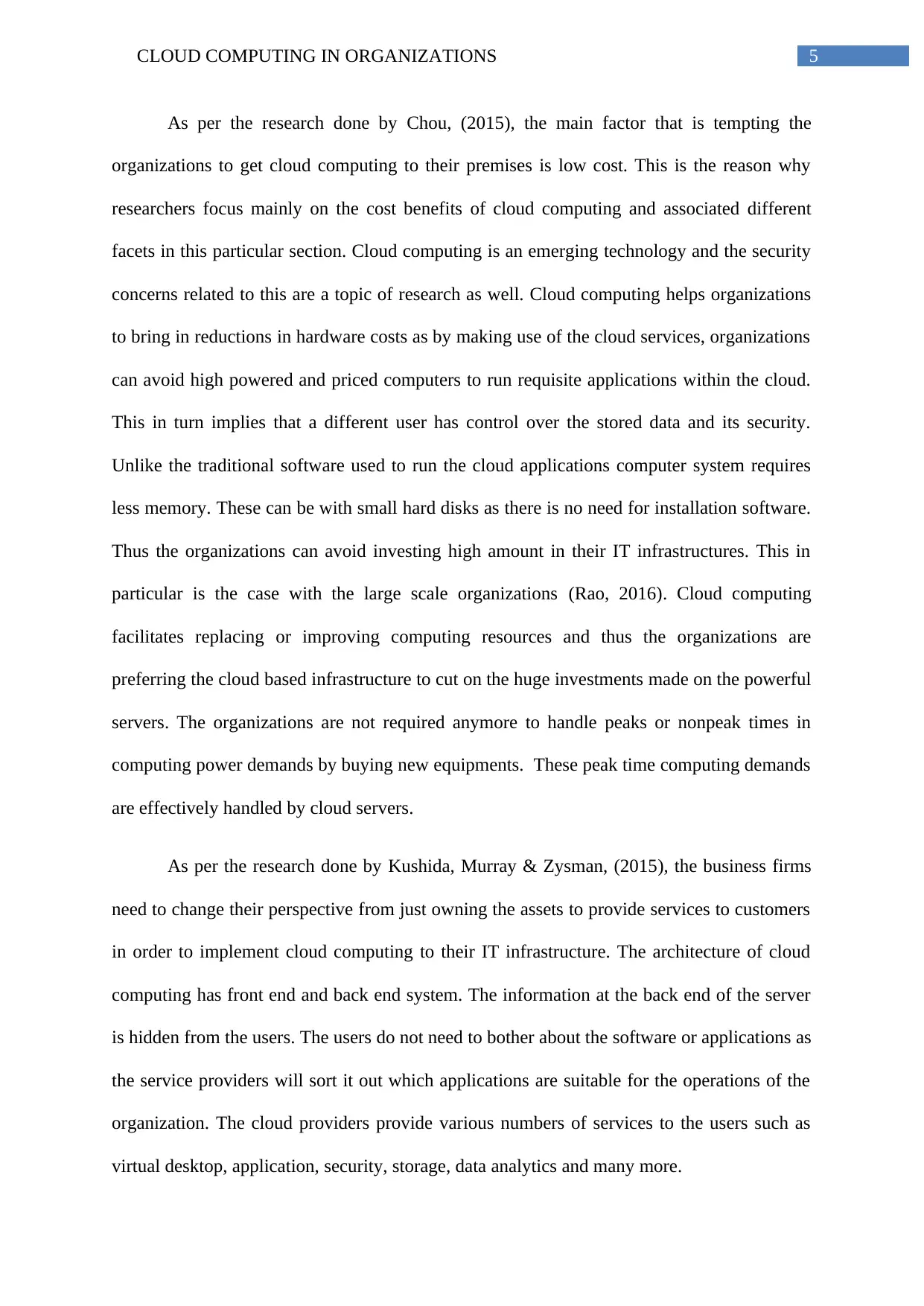
5CLOUD COMPUTING IN ORGANIZATIONS
As per the research done by Chou, (2015), the main factor that is tempting the
organizations to get cloud computing to their premises is low cost. This is the reason why
researchers focus mainly on the cost benefits of cloud computing and associated different
facets in this particular section. Cloud computing is an emerging technology and the security
concerns related to this are a topic of research as well. Cloud computing helps organizations
to bring in reductions in hardware costs as by making use of the cloud services, organizations
can avoid high powered and priced computers to run requisite applications within the cloud.
This in turn implies that a different user has control over the stored data and its security.
Unlike the traditional software used to run the cloud applications computer system requires
less memory. These can be with small hard disks as there is no need for installation software.
Thus the organizations can avoid investing high amount in their IT infrastructures. This in
particular is the case with the large scale organizations (Rao, 2016). Cloud computing
facilitates replacing or improving computing resources and thus the organizations are
preferring the cloud based infrastructure to cut on the huge investments made on the powerful
servers. The organizations are not required anymore to handle peaks or nonpeak times in
computing power demands by buying new equipments. These peak time computing demands
are effectively handled by cloud servers.
As per the research done by Kushida, Murray & Zysman, (2015), the business firms
need to change their perspective from just owning the assets to provide services to customers
in order to implement cloud computing to their IT infrastructure. The architecture of cloud
computing has front end and back end system. The information at the back end of the server
is hidden from the users. The users do not need to bother about the software or applications as
the service providers will sort it out which applications are suitable for the operations of the
organization. The cloud providers provide various numbers of services to the users such as
virtual desktop, application, security, storage, data analytics and many more.
As per the research done by Chou, (2015), the main factor that is tempting the
organizations to get cloud computing to their premises is low cost. This is the reason why
researchers focus mainly on the cost benefits of cloud computing and associated different
facets in this particular section. Cloud computing is an emerging technology and the security
concerns related to this are a topic of research as well. Cloud computing helps organizations
to bring in reductions in hardware costs as by making use of the cloud services, organizations
can avoid high powered and priced computers to run requisite applications within the cloud.
This in turn implies that a different user has control over the stored data and its security.
Unlike the traditional software used to run the cloud applications computer system requires
less memory. These can be with small hard disks as there is no need for installation software.
Thus the organizations can avoid investing high amount in their IT infrastructures. This in
particular is the case with the large scale organizations (Rao, 2016). Cloud computing
facilitates replacing or improving computing resources and thus the organizations are
preferring the cloud based infrastructure to cut on the huge investments made on the powerful
servers. The organizations are not required anymore to handle peaks or nonpeak times in
computing power demands by buying new equipments. These peak time computing demands
are effectively handled by cloud servers.
As per the research done by Kushida, Murray & Zysman, (2015), the business firms
need to change their perspective from just owning the assets to provide services to customers
in order to implement cloud computing to their IT infrastructure. The architecture of cloud
computing has front end and back end system. The information at the back end of the server
is hidden from the users. The users do not need to bother about the software or applications as
the service providers will sort it out which applications are suitable for the operations of the
organization. The cloud providers provide various numbers of services to the users such as
virtual desktop, application, security, storage, data analytics and many more.
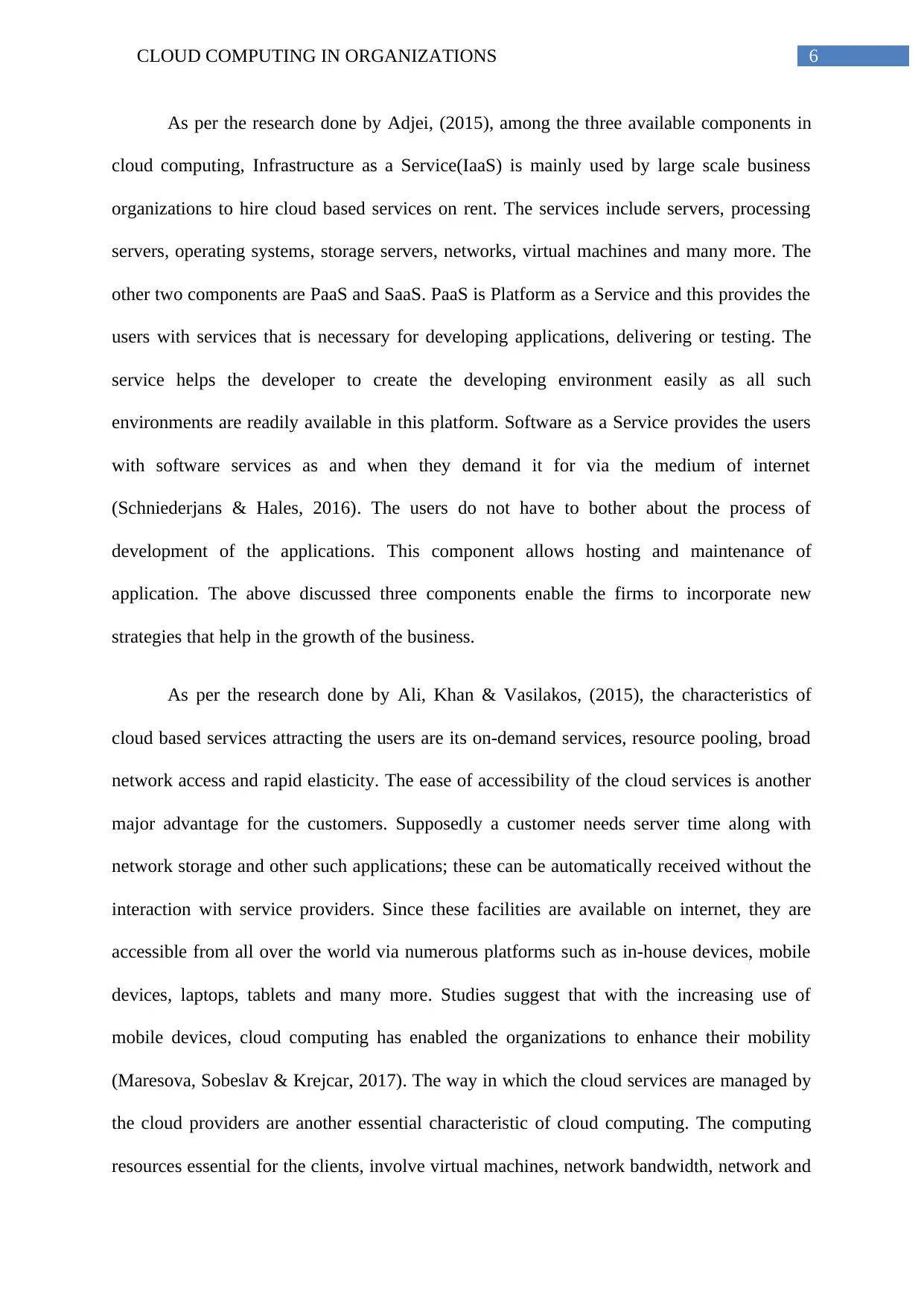
6CLOUD COMPUTING IN ORGANIZATIONS
As per the research done by Adjei, (2015), among the three available components in
cloud computing, Infrastructure as a Service(IaaS) is mainly used by large scale business
organizations to hire cloud based services on rent. The services include servers, processing
servers, operating systems, storage servers, networks, virtual machines and many more. The
other two components are PaaS and SaaS. PaaS is Platform as a Service and this provides the
users with services that is necessary for developing applications, delivering or testing. The
service helps the developer to create the developing environment easily as all such
environments are readily available in this platform. Software as a Service provides the users
with software services as and when they demand it for via the medium of internet
(Schniederjans & Hales, 2016). The users do not have to bother about the process of
development of the applications. This component allows hosting and maintenance of
application. The above discussed three components enable the firms to incorporate new
strategies that help in the growth of the business.
As per the research done by Ali, Khan & Vasilakos, (2015), the characteristics of
cloud based services attracting the users are its on-demand services, resource pooling, broad
network access and rapid elasticity. The ease of accessibility of the cloud services is another
major advantage for the customers. Supposedly a customer needs server time along with
network storage and other such applications; these can be automatically received without the
interaction with service providers. Since these facilities are available on internet, they are
accessible from all over the world via numerous platforms such as in-house devices, mobile
devices, laptops, tablets and many more. Studies suggest that with the increasing use of
mobile devices, cloud computing has enabled the organizations to enhance their mobility
(Maresova, Sobeslav & Krejcar, 2017). The way in which the cloud services are managed by
the cloud providers are another essential characteristic of cloud computing. The computing
resources essential for the clients, involve virtual machines, network bandwidth, network and
As per the research done by Adjei, (2015), among the three available components in
cloud computing, Infrastructure as a Service(IaaS) is mainly used by large scale business
organizations to hire cloud based services on rent. The services include servers, processing
servers, operating systems, storage servers, networks, virtual machines and many more. The
other two components are PaaS and SaaS. PaaS is Platform as a Service and this provides the
users with services that is necessary for developing applications, delivering or testing. The
service helps the developer to create the developing environment easily as all such
environments are readily available in this platform. Software as a Service provides the users
with software services as and when they demand it for via the medium of internet
(Schniederjans & Hales, 2016). The users do not have to bother about the process of
development of the applications. This component allows hosting and maintenance of
application. The above discussed three components enable the firms to incorporate new
strategies that help in the growth of the business.
As per the research done by Ali, Khan & Vasilakos, (2015), the characteristics of
cloud based services attracting the users are its on-demand services, resource pooling, broad
network access and rapid elasticity. The ease of accessibility of the cloud services is another
major advantage for the customers. Supposedly a customer needs server time along with
network storage and other such applications; these can be automatically received without the
interaction with service providers. Since these facilities are available on internet, they are
accessible from all over the world via numerous platforms such as in-house devices, mobile
devices, laptops, tablets and many more. Studies suggest that with the increasing use of
mobile devices, cloud computing has enabled the organizations to enhance their mobility
(Maresova, Sobeslav & Krejcar, 2017). The way in which the cloud services are managed by
the cloud providers are another essential characteristic of cloud computing. The computing
resources essential for the clients, involve virtual machines, network bandwidth, network and
Paraphrase This Document
Need a fresh take? Get an instant paraphrase of this document with our AI Paraphraser
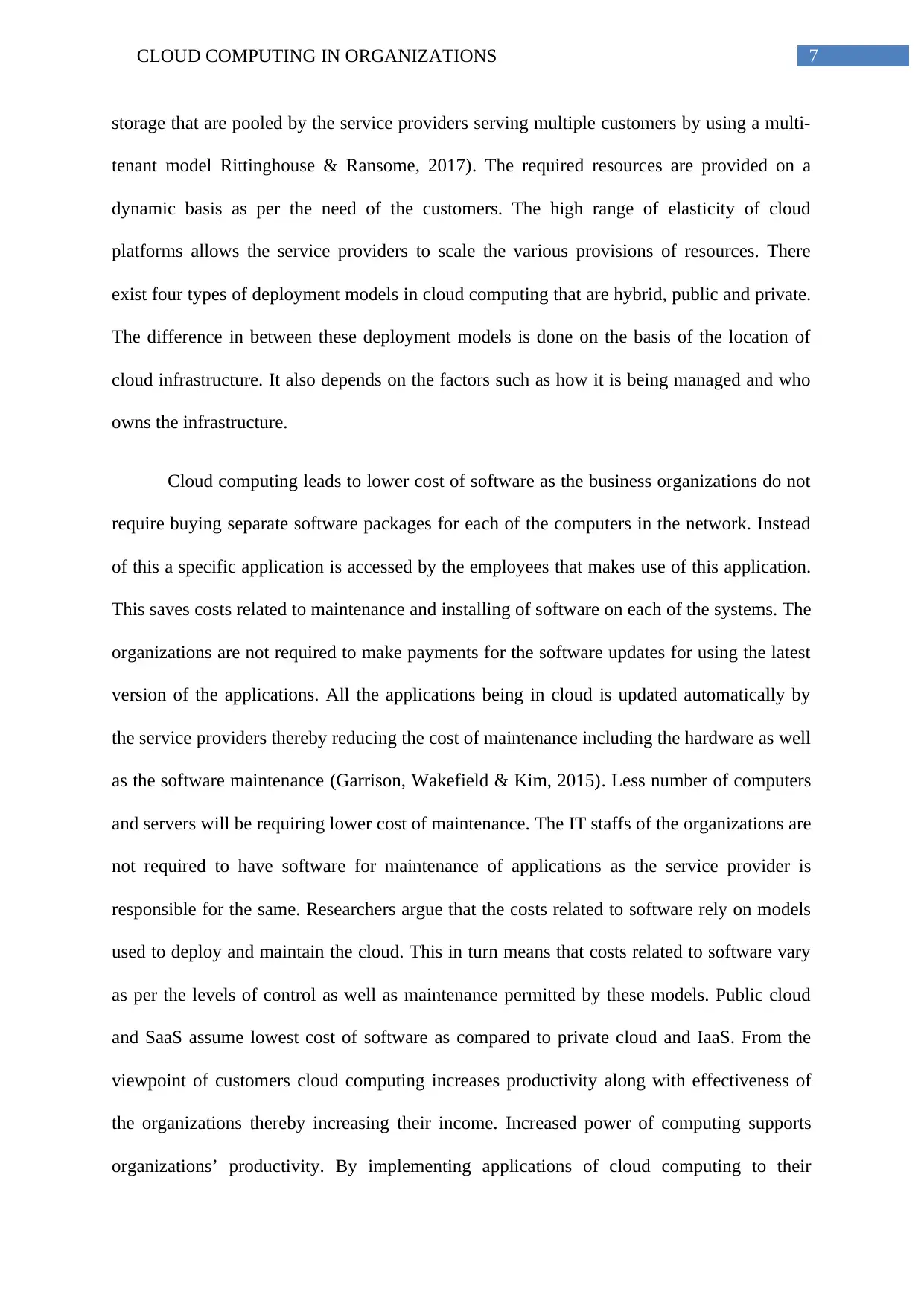
7CLOUD COMPUTING IN ORGANIZATIONS
storage that are pooled by the service providers serving multiple customers by using a multi-
tenant model Rittinghouse & Ransome, 2017). The required resources are provided on a
dynamic basis as per the need of the customers. The high range of elasticity of cloud
platforms allows the service providers to scale the various provisions of resources. There
exist four types of deployment models in cloud computing that are hybrid, public and private.
The difference in between these deployment models is done on the basis of the location of
cloud infrastructure. It also depends on the factors such as how it is being managed and who
owns the infrastructure.
Cloud computing leads to lower cost of software as the business organizations do not
require buying separate software packages for each of the computers in the network. Instead
of this a specific application is accessed by the employees that makes use of this application.
This saves costs related to maintenance and installing of software on each of the systems. The
organizations are not required to make payments for the software updates for using the latest
version of the applications. All the applications being in cloud is updated automatically by
the service providers thereby reducing the cost of maintenance including the hardware as well
as the software maintenance (Garrison, Wakefield & Kim, 2015). Less number of computers
and servers will be requiring lower cost of maintenance. The IT staffs of the organizations are
not required to have software for maintenance of applications as the service provider is
responsible for the same. Researchers argue that the costs related to software rely on models
used to deploy and maintain the cloud. This in turn means that costs related to software vary
as per the levels of control as well as maintenance permitted by these models. Public cloud
and SaaS assume lowest cost of software as compared to private cloud and IaaS. From the
viewpoint of customers cloud computing increases productivity along with effectiveness of
the organizations thereby increasing their income. Increased power of computing supports
organizations’ productivity. By implementing applications of cloud computing to their
storage that are pooled by the service providers serving multiple customers by using a multi-
tenant model Rittinghouse & Ransome, 2017). The required resources are provided on a
dynamic basis as per the need of the customers. The high range of elasticity of cloud
platforms allows the service providers to scale the various provisions of resources. There
exist four types of deployment models in cloud computing that are hybrid, public and private.
The difference in between these deployment models is done on the basis of the location of
cloud infrastructure. It also depends on the factors such as how it is being managed and who
owns the infrastructure.
Cloud computing leads to lower cost of software as the business organizations do not
require buying separate software packages for each of the computers in the network. Instead
of this a specific application is accessed by the employees that makes use of this application.
This saves costs related to maintenance and installing of software on each of the systems. The
organizations are not required to make payments for the software updates for using the latest
version of the applications. All the applications being in cloud is updated automatically by
the service providers thereby reducing the cost of maintenance including the hardware as well
as the software maintenance (Garrison, Wakefield & Kim, 2015). Less number of computers
and servers will be requiring lower cost of maintenance. The IT staffs of the organizations are
not required to have software for maintenance of applications as the service provider is
responsible for the same. Researchers argue that the costs related to software rely on models
used to deploy and maintain the cloud. This in turn means that costs related to software vary
as per the levels of control as well as maintenance permitted by these models. Public cloud
and SaaS assume lowest cost of software as compared to private cloud and IaaS. From the
viewpoint of customers cloud computing increases productivity along with effectiveness of
the organizations thereby increasing their income. Increased power of computing supports
organizations’ productivity. By implementing applications of cloud computing to their
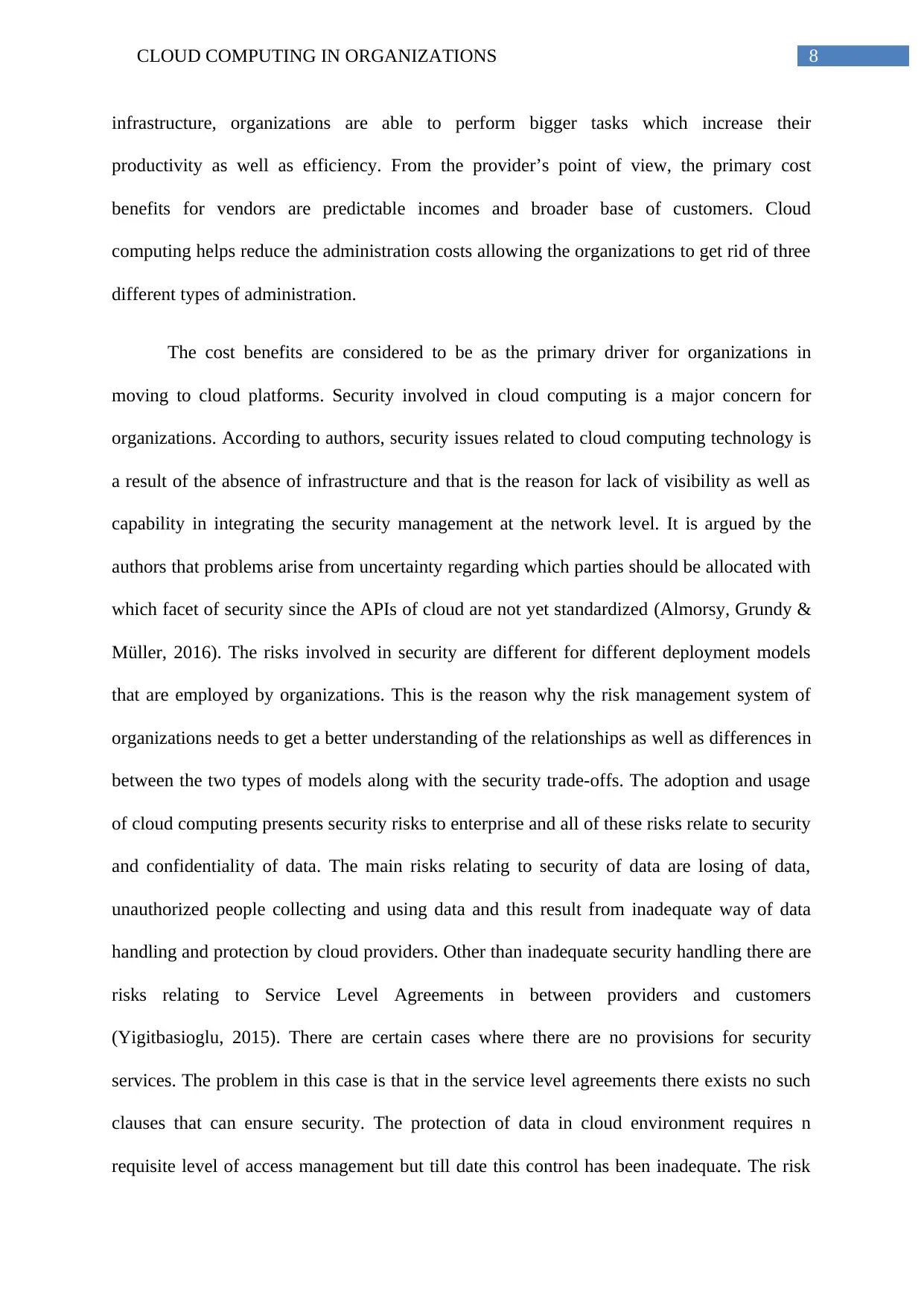
8CLOUD COMPUTING IN ORGANIZATIONS
infrastructure, organizations are able to perform bigger tasks which increase their
productivity as well as efficiency. From the provider’s point of view, the primary cost
benefits for vendors are predictable incomes and broader base of customers. Cloud
computing helps reduce the administration costs allowing the organizations to get rid of three
different types of administration.
The cost benefits are considered to be as the primary driver for organizations in
moving to cloud platforms. Security involved in cloud computing is a major concern for
organizations. According to authors, security issues related to cloud computing technology is
a result of the absence of infrastructure and that is the reason for lack of visibility as well as
capability in integrating the security management at the network level. It is argued by the
authors that problems arise from uncertainty regarding which parties should be allocated with
which facet of security since the APIs of cloud are not yet standardized (Almorsy, Grundy &
Müller, 2016). The risks involved in security are different for different deployment models
that are employed by organizations. This is the reason why the risk management system of
organizations needs to get a better understanding of the relationships as well as differences in
between the two types of models along with the security trade-offs. The adoption and usage
of cloud computing presents security risks to enterprise and all of these risks relate to security
and confidentiality of data. The main risks relating to security of data are losing of data,
unauthorized people collecting and using data and this result from inadequate way of data
handling and protection by cloud providers. Other than inadequate security handling there are
risks relating to Service Level Agreements in between providers and customers
(Yigitbasioglu, 2015). There are certain cases where there are no provisions for security
services. The problem in this case is that in the service level agreements there exists no such
clauses that can ensure security. The protection of data in cloud environment requires n
requisite level of access management but till date this control has been inadequate. The risk
infrastructure, organizations are able to perform bigger tasks which increase their
productivity as well as efficiency. From the provider’s point of view, the primary cost
benefits for vendors are predictable incomes and broader base of customers. Cloud
computing helps reduce the administration costs allowing the organizations to get rid of three
different types of administration.
The cost benefits are considered to be as the primary driver for organizations in
moving to cloud platforms. Security involved in cloud computing is a major concern for
organizations. According to authors, security issues related to cloud computing technology is
a result of the absence of infrastructure and that is the reason for lack of visibility as well as
capability in integrating the security management at the network level. It is argued by the
authors that problems arise from uncertainty regarding which parties should be allocated with
which facet of security since the APIs of cloud are not yet standardized (Almorsy, Grundy &
Müller, 2016). The risks involved in security are different for different deployment models
that are employed by organizations. This is the reason why the risk management system of
organizations needs to get a better understanding of the relationships as well as differences in
between the two types of models along with the security trade-offs. The adoption and usage
of cloud computing presents security risks to enterprise and all of these risks relate to security
and confidentiality of data. The main risks relating to security of data are losing of data,
unauthorized people collecting and using data and this result from inadequate way of data
handling and protection by cloud providers. Other than inadequate security handling there are
risks relating to Service Level Agreements in between providers and customers
(Yigitbasioglu, 2015). There are certain cases where there are no provisions for security
services. The problem in this case is that in the service level agreements there exists no such
clauses that can ensure security. The protection of data in cloud environment requires n
requisite level of access management but till date this control has been inadequate. The risk
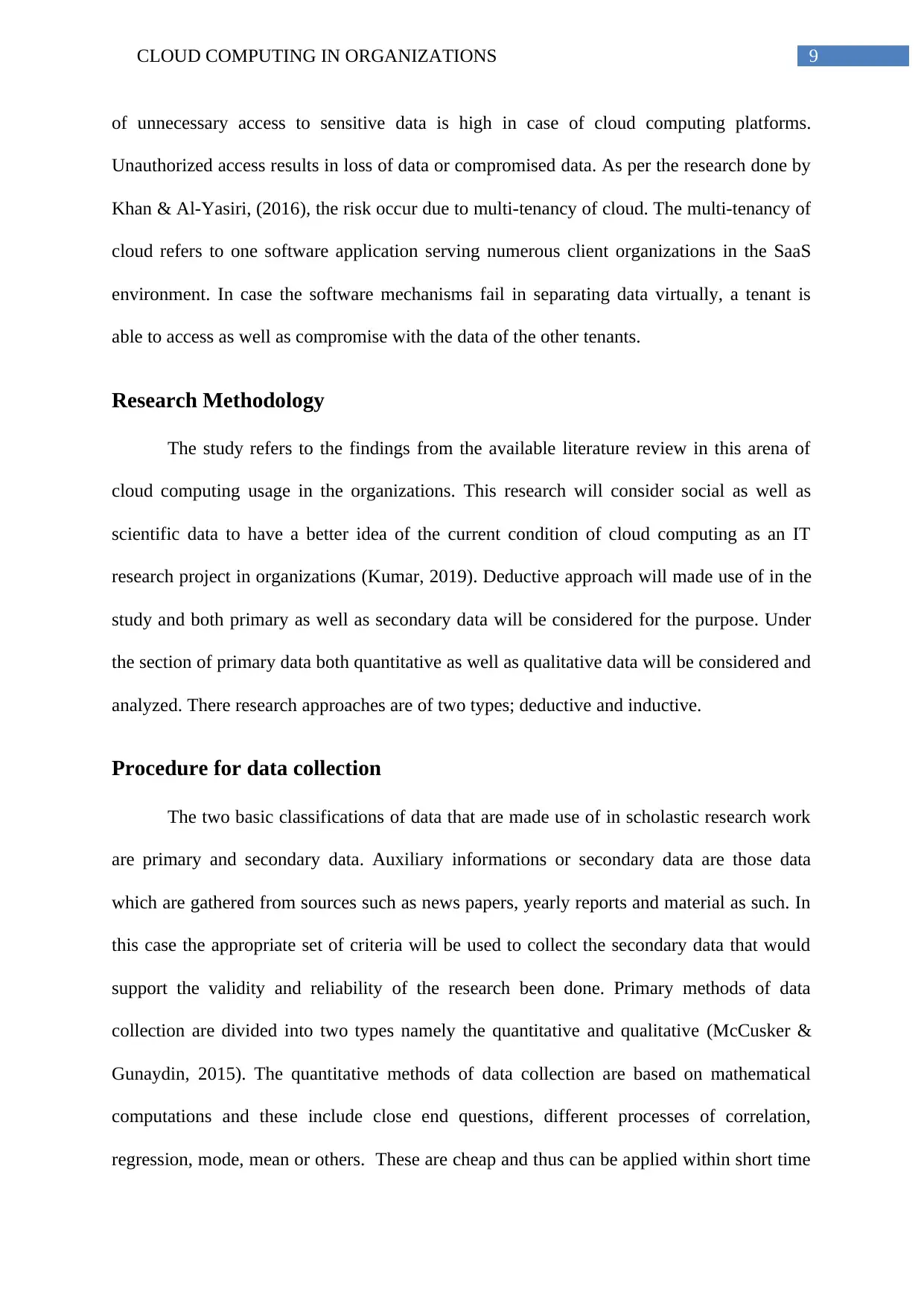
9CLOUD COMPUTING IN ORGANIZATIONS
of unnecessary access to sensitive data is high in case of cloud computing platforms.
Unauthorized access results in loss of data or compromised data. As per the research done by
Khan & Al-Yasiri, (2016), the risk occur due to multi-tenancy of cloud. The multi-tenancy of
cloud refers to one software application serving numerous client organizations in the SaaS
environment. In case the software mechanisms fail in separating data virtually, a tenant is
able to access as well as compromise with the data of the other tenants.
Research Methodology
The study refers to the findings from the available literature review in this arena of
cloud computing usage in the organizations. This research will consider social as well as
scientific data to have a better idea of the current condition of cloud computing as an IT
research project in organizations (Kumar, 2019). Deductive approach will made use of in the
study and both primary as well as secondary data will be considered for the purpose. Under
the section of primary data both quantitative as well as qualitative data will be considered and
analyzed. There research approaches are of two types; deductive and inductive.
Procedure for data collection
The two basic classifications of data that are made use of in scholastic research work
are primary and secondary data. Auxiliary informations or secondary data are those data
which are gathered from sources such as news papers, yearly reports and material as such. In
this case the appropriate set of criteria will be used to collect the secondary data that would
support the validity and reliability of the research been done. Primary methods of data
collection are divided into two types namely the quantitative and qualitative (McCusker &
Gunaydin, 2015). The quantitative methods of data collection are based on mathematical
computations and these include close end questions, different processes of correlation,
regression, mode, mean or others. These are cheap and thus can be applied within short time
of unnecessary access to sensitive data is high in case of cloud computing platforms.
Unauthorized access results in loss of data or compromised data. As per the research done by
Khan & Al-Yasiri, (2016), the risk occur due to multi-tenancy of cloud. The multi-tenancy of
cloud refers to one software application serving numerous client organizations in the SaaS
environment. In case the software mechanisms fail in separating data virtually, a tenant is
able to access as well as compromise with the data of the other tenants.
Research Methodology
The study refers to the findings from the available literature review in this arena of
cloud computing usage in the organizations. This research will consider social as well as
scientific data to have a better idea of the current condition of cloud computing as an IT
research project in organizations (Kumar, 2019). Deductive approach will made use of in the
study and both primary as well as secondary data will be considered for the purpose. Under
the section of primary data both quantitative as well as qualitative data will be considered and
analyzed. There research approaches are of two types; deductive and inductive.
Procedure for data collection
The two basic classifications of data that are made use of in scholastic research work
are primary and secondary data. Auxiliary informations or secondary data are those data
which are gathered from sources such as news papers, yearly reports and material as such. In
this case the appropriate set of criteria will be used to collect the secondary data that would
support the validity and reliability of the research been done. Primary methods of data
collection are divided into two types namely the quantitative and qualitative (McCusker &
Gunaydin, 2015). The quantitative methods of data collection are based on mathematical
computations and these include close end questions, different processes of correlation,
regression, mode, mean or others. These are cheap and thus can be applied within short time
Secure Best Marks with AI Grader
Need help grading? Try our AI Grader for instant feedback on your assignments.
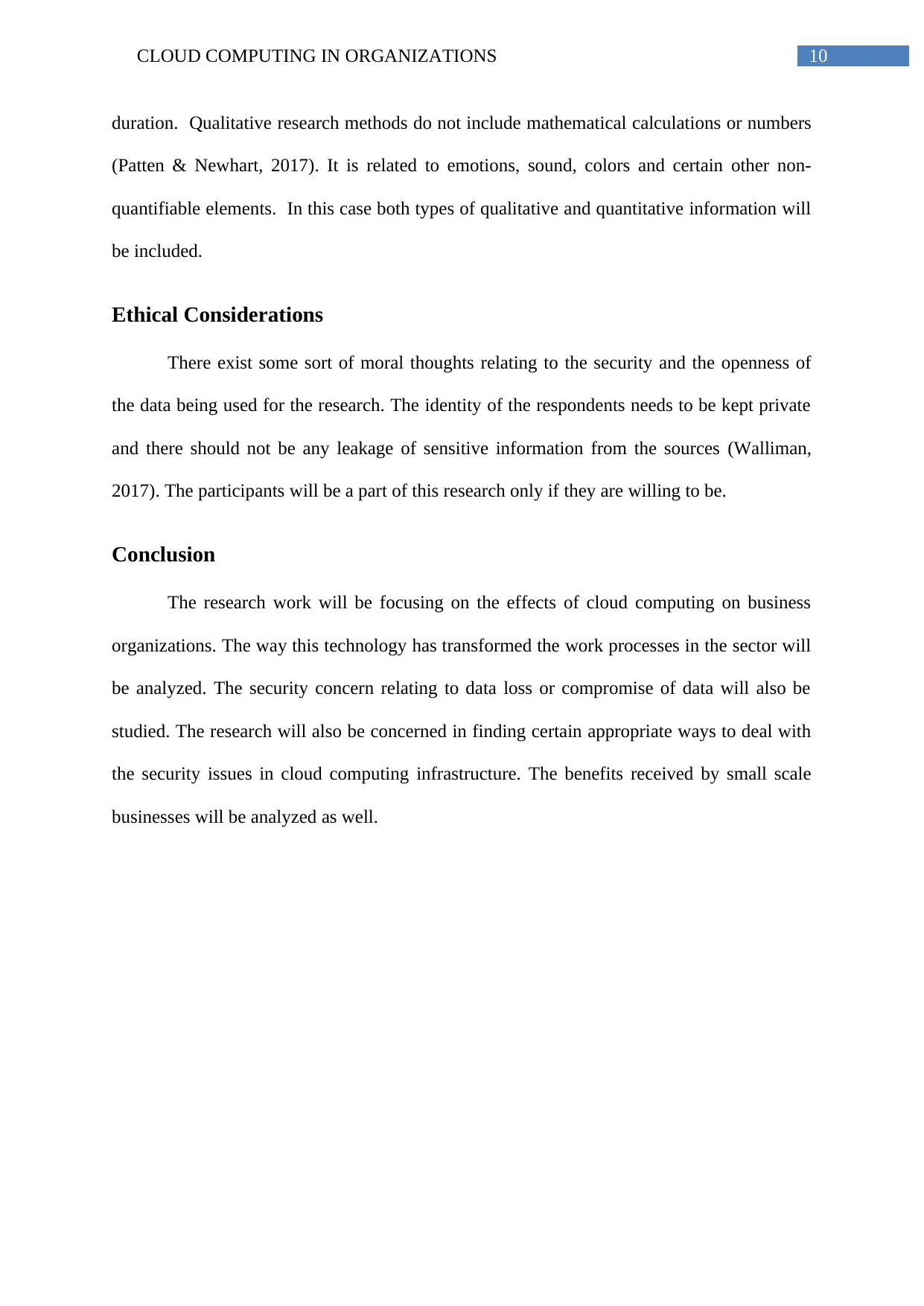
10CLOUD COMPUTING IN ORGANIZATIONS
duration. Qualitative research methods do not include mathematical calculations or numbers
(Patten & Newhart, 2017). It is related to emotions, sound, colors and certain other non-
quantifiable elements. In this case both types of qualitative and quantitative information will
be included.
Ethical Considerations
There exist some sort of moral thoughts relating to the security and the openness of
the data being used for the research. The identity of the respondents needs to be kept private
and there should not be any leakage of sensitive information from the sources (Walliman,
2017). The participants will be a part of this research only if they are willing to be.
Conclusion
The research work will be focusing on the effects of cloud computing on business
organizations. The way this technology has transformed the work processes in the sector will
be analyzed. The security concern relating to data loss or compromise of data will also be
studied. The research will also be concerned in finding certain appropriate ways to deal with
the security issues in cloud computing infrastructure. The benefits received by small scale
businesses will be analyzed as well.
duration. Qualitative research methods do not include mathematical calculations or numbers
(Patten & Newhart, 2017). It is related to emotions, sound, colors and certain other non-
quantifiable elements. In this case both types of qualitative and quantitative information will
be included.
Ethical Considerations
There exist some sort of moral thoughts relating to the security and the openness of
the data being used for the research. The identity of the respondents needs to be kept private
and there should not be any leakage of sensitive information from the sources (Walliman,
2017). The participants will be a part of this research only if they are willing to be.
Conclusion
The research work will be focusing on the effects of cloud computing on business
organizations. The way this technology has transformed the work processes in the sector will
be analyzed. The security concern relating to data loss or compromise of data will also be
studied. The research will also be concerned in finding certain appropriate ways to deal with
the security issues in cloud computing infrastructure. The benefits received by small scale
businesses will be analyzed as well.
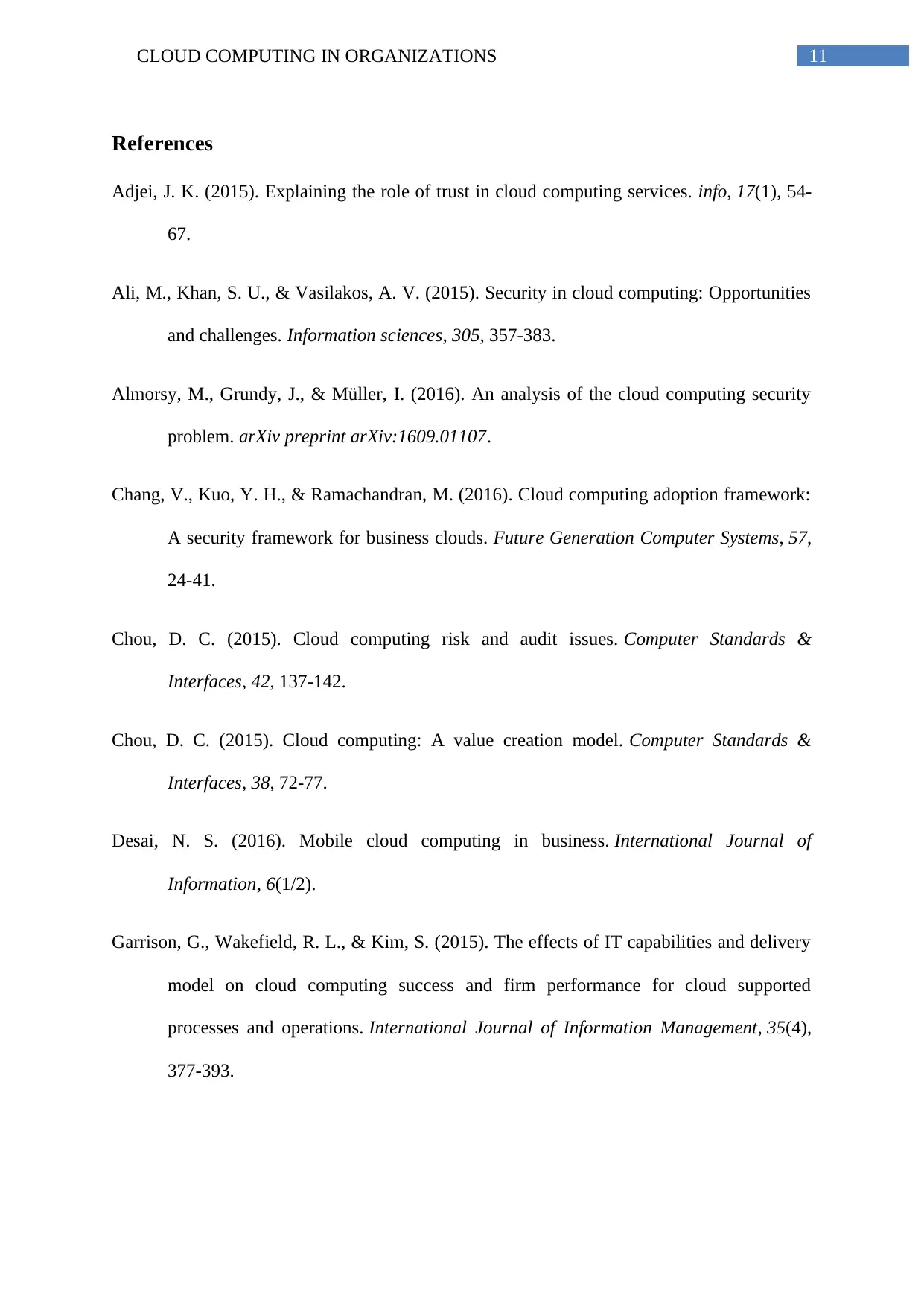
11CLOUD COMPUTING IN ORGANIZATIONS
References
Adjei, J. K. (2015). Explaining the role of trust in cloud computing services. info, 17(1), 54-
67.
Ali, M., Khan, S. U., & Vasilakos, A. V. (2015). Security in cloud computing: Opportunities
and challenges. Information sciences, 305, 357-383.
Almorsy, M., Grundy, J., & Müller, I. (2016). An analysis of the cloud computing security
problem. arXiv preprint arXiv:1609.01107.
Chang, V., Kuo, Y. H., & Ramachandran, M. (2016). Cloud computing adoption framework:
A security framework for business clouds. Future Generation Computer Systems, 57,
24-41.
Chou, D. C. (2015). Cloud computing risk and audit issues. Computer Standards &
Interfaces, 42, 137-142.
Chou, D. C. (2015). Cloud computing: A value creation model. Computer Standards &
Interfaces, 38, 72-77.
Desai, N. S. (2016). Mobile cloud computing in business. International Journal of
Information, 6(1/2).
Garrison, G., Wakefield, R. L., & Kim, S. (2015). The effects of IT capabilities and delivery
model on cloud computing success and firm performance for cloud supported
processes and operations. International Journal of Information Management, 35(4),
377-393.
References
Adjei, J. K. (2015). Explaining the role of trust in cloud computing services. info, 17(1), 54-
67.
Ali, M., Khan, S. U., & Vasilakos, A. V. (2015). Security in cloud computing: Opportunities
and challenges. Information sciences, 305, 357-383.
Almorsy, M., Grundy, J., & Müller, I. (2016). An analysis of the cloud computing security
problem. arXiv preprint arXiv:1609.01107.
Chang, V., Kuo, Y. H., & Ramachandran, M. (2016). Cloud computing adoption framework:
A security framework for business clouds. Future Generation Computer Systems, 57,
24-41.
Chou, D. C. (2015). Cloud computing risk and audit issues. Computer Standards &
Interfaces, 42, 137-142.
Chou, D. C. (2015). Cloud computing: A value creation model. Computer Standards &
Interfaces, 38, 72-77.
Desai, N. S. (2016). Mobile cloud computing in business. International Journal of
Information, 6(1/2).
Garrison, G., Wakefield, R. L., & Kim, S. (2015). The effects of IT capabilities and delivery
model on cloud computing success and firm performance for cloud supported
processes and operations. International Journal of Information Management, 35(4),
377-393.
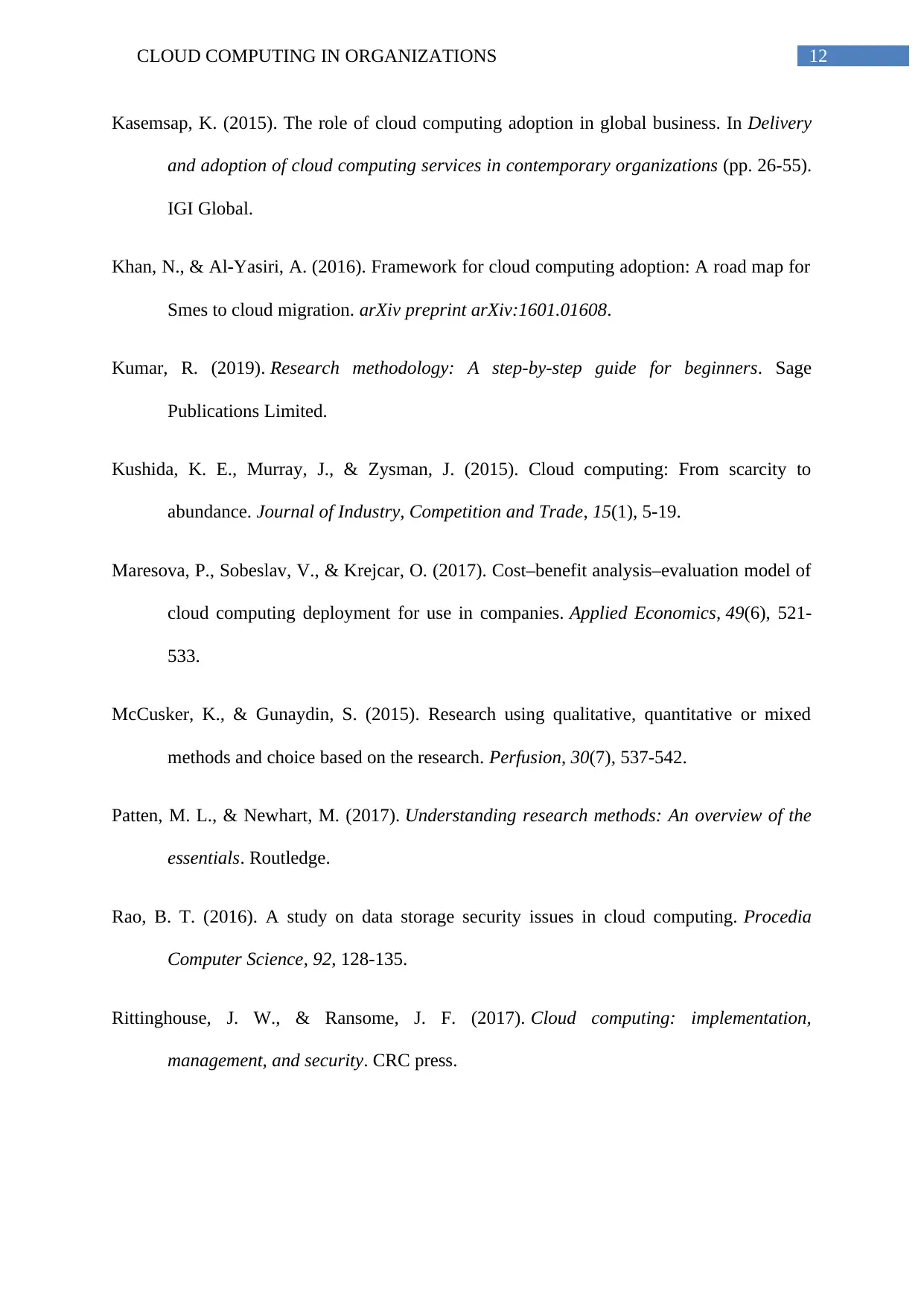
12CLOUD COMPUTING IN ORGANIZATIONS
Kasemsap, K. (2015). The role of cloud computing adoption in global business. In Delivery
and adoption of cloud computing services in contemporary organizations (pp. 26-55).
IGI Global.
Khan, N., & Al-Yasiri, A. (2016). Framework for cloud computing adoption: A road map for
Smes to cloud migration. arXiv preprint arXiv:1601.01608.
Kumar, R. (2019). Research methodology: A step-by-step guide for beginners. Sage
Publications Limited.
Kushida, K. E., Murray, J., & Zysman, J. (2015). Cloud computing: From scarcity to
abundance. Journal of Industry, Competition and Trade, 15(1), 5-19.
Maresova, P., Sobeslav, V., & Krejcar, O. (2017). Cost–benefit analysis–evaluation model of
cloud computing deployment for use in companies. Applied Economics, 49(6), 521-
533.
McCusker, K., & Gunaydin, S. (2015). Research using qualitative, quantitative or mixed
methods and choice based on the research. Perfusion, 30(7), 537-542.
Patten, M. L., & Newhart, M. (2017). Understanding research methods: An overview of the
essentials. Routledge.
Rao, B. T. (2016). A study on data storage security issues in cloud computing. Procedia
Computer Science, 92, 128-135.
Rittinghouse, J. W., & Ransome, J. F. (2017). Cloud computing: implementation,
management, and security. CRC press.
Kasemsap, K. (2015). The role of cloud computing adoption in global business. In Delivery
and adoption of cloud computing services in contemporary organizations (pp. 26-55).
IGI Global.
Khan, N., & Al-Yasiri, A. (2016). Framework for cloud computing adoption: A road map for
Smes to cloud migration. arXiv preprint arXiv:1601.01608.
Kumar, R. (2019). Research methodology: A step-by-step guide for beginners. Sage
Publications Limited.
Kushida, K. E., Murray, J., & Zysman, J. (2015). Cloud computing: From scarcity to
abundance. Journal of Industry, Competition and Trade, 15(1), 5-19.
Maresova, P., Sobeslav, V., & Krejcar, O. (2017). Cost–benefit analysis–evaluation model of
cloud computing deployment for use in companies. Applied Economics, 49(6), 521-
533.
McCusker, K., & Gunaydin, S. (2015). Research using qualitative, quantitative or mixed
methods and choice based on the research. Perfusion, 30(7), 537-542.
Patten, M. L., & Newhart, M. (2017). Understanding research methods: An overview of the
essentials. Routledge.
Rao, B. T. (2016). A study on data storage security issues in cloud computing. Procedia
Computer Science, 92, 128-135.
Rittinghouse, J. W., & Ransome, J. F. (2017). Cloud computing: implementation,
management, and security. CRC press.
Paraphrase This Document
Need a fresh take? Get an instant paraphrase of this document with our AI Paraphraser
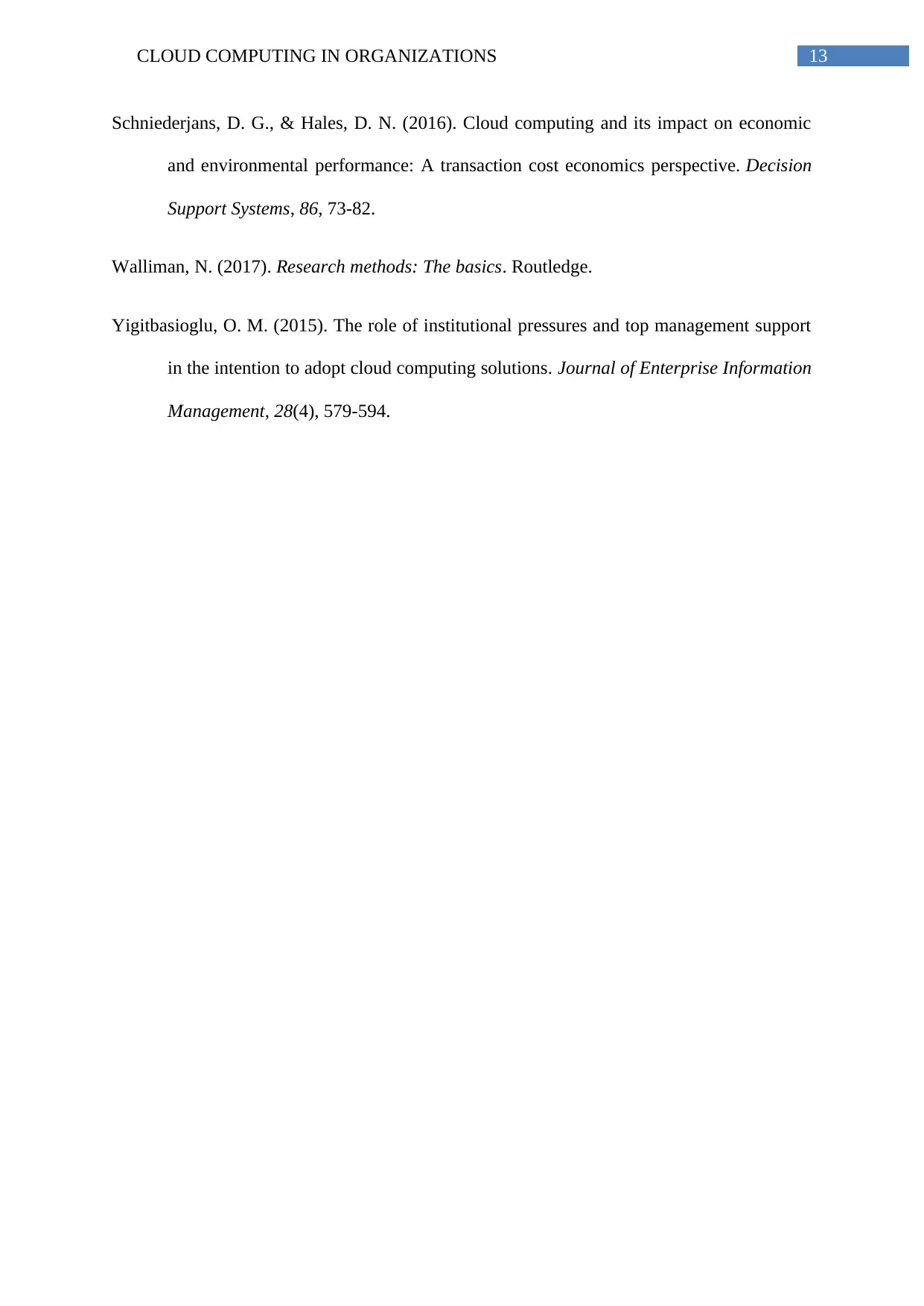
13CLOUD COMPUTING IN ORGANIZATIONS
Schniederjans, D. G., & Hales, D. N. (2016). Cloud computing and its impact on economic
and environmental performance: A transaction cost economics perspective. Decision
Support Systems, 86, 73-82.
Walliman, N. (2017). Research methods: The basics. Routledge.
Yigitbasioglu, O. M. (2015). The role of institutional pressures and top management support
in the intention to adopt cloud computing solutions. Journal of Enterprise Information
Management, 28(4), 579-594.
Schniederjans, D. G., & Hales, D. N. (2016). Cloud computing and its impact on economic
and environmental performance: A transaction cost economics perspective. Decision
Support Systems, 86, 73-82.
Walliman, N. (2017). Research methods: The basics. Routledge.
Yigitbasioglu, O. M. (2015). The role of institutional pressures and top management support
in the intention to adopt cloud computing solutions. Journal of Enterprise Information
Management, 28(4), 579-594.
1 out of 14
Related Documents
Your All-in-One AI-Powered Toolkit for Academic Success.
+13062052269
info@desklib.com
Available 24*7 on WhatsApp / Email
![[object Object]](/_next/static/media/star-bottom.7253800d.svg)
Unlock your academic potential
© 2024 | Zucol Services PVT LTD | All rights reserved.





